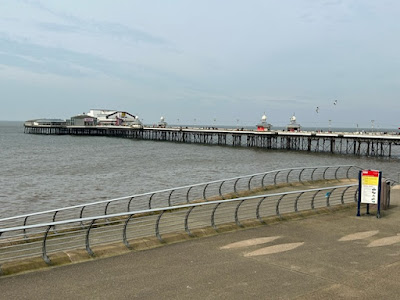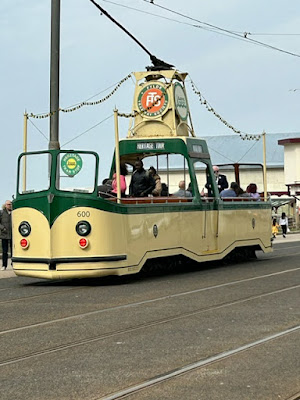Sepia Saturday's prompt photograph this week is of a crowded Blackpool beach at the turn of the 19th-20th century. How could I NOT respond to this? For I am a Blackpudlian, born in this popular seaside resort in north west England? but what do I lack? Photographs of crowds on the beach or on the promenades. However I can give you picture of what Blackpool is like.

Blackpool is most famous for its Tower, built in 1894, modelled on the Eiffel Tower. It rises to 520 feet - facts drummed into us at school.
Until the 19th century, Blackpool was just a
small hamlet. It rose to prominence with the building of the
railway linking it to the mill towns of industrial Lancashire and
Yorkshire and soon became England's most popular holiday resort. The
unique Blackpool Illuminations were first switched on in 1879 to extend
the season well into late autumn.
You can get a cranky lift to the top of the Tower and stand on a scary glass floor to view the town below.

Many seaside towns have one pier - but Blackpool goes two better with three - the North, Central and South Piers. A visit to Blackpool would not be complete without buying an ice-cream cone and walking to the end of the pier - an often very breezy experience.

Central Pier with the Tower in the background - we tended to return to visit family in the quiet "off season" - hence the deserted beach.
An even quieter scene of the North Pier and the Promenade.
Blackpool is also famous for its trams that run along the length of the sea shore.
Blackpool sign on the side of the side of the trams - the inner crest with the seagull was also my school badge.

Some Family Memories
The Winter Gardens Entertainment Complex opened in 1878.
It includes a theatre, ballroom and meeting facilities, once the regular venue for the annual party political conferences. The Empress Ballroom was built in 1896 and with a floor area of 12,500 square feet (1,160 sq. metres),was one of the largest in the world.
This is where my parents first met in 1936 - and married two years later.

The earliest picture of me enjoying the beach - and could that be a crowd in the background? I reckon it was taken June 1945, as Dad is in uniform and I know he had leave between marking VE Day in Germany and then being posted out to the Far East, where he was for VJ Day.

On the North Pier, 1970s. Looking back, I don't know why I was dressed quite so formally in my best winter coat, skirt and court shoes.

Daughter on another breezy Blackpool day in the 1980s

Daughter (in the middle) enjoying a donkey ride on Blackpool beach. This was taken in the school October half term holiday, so not exactly summery. c.1980.
And Finally: Not Blackpool - but I finish with people enjoying themselves on the beach, as in the prompt photograph.

On the left, wearing the cloche hat is my husband's Great Aunt Pat, beside her daughter Annette - with unknown friends. Judging by the fashions and the age of Annette, it was most likely taken in the late 1920's on the beach at Margate in Kent, where the family lived.
****************
their family history and memories through photographs.





Wonderful photos showing different aspects of Blackpool! I love hearing you are a Blackpudlian! Great name for those from there! The rest of the world may just visit!
ReplyDeleteI've heard of Blackpool, but never saw it. Thanks for the tour of this seaside city.
ReplyDeleteSusan
Though my father-in-law was from Blackpool, somehow I've never managed to visit it yet. That's something I'll have to fix on our next holiday in Britain. However I have visited a few other seaside resorts, usually in the off-season, and learned to appreciate the stoic British recreational culture which is very different from America. And of course, I have collected a number of photo postcards of seaside promenade orchestras and bands which introduced me to the music/theater aspect of these resorts.
ReplyDeleteFrom Scotsue - thank you all for your comments - I was delighted to get them after some initial glitches on posting here.
ReplyDeleteI'm pleased you liked my story on the Harvard orchestra. I meant to include the definition of the Perian Sodality but forgot and have now added it. The word "pierian" refers to the Pierian Spring of Macedonia in Greek mythology, which was sacred to the Pierides who worshiped the Muses, the goddesses of literature, science, and the arts. It was used as a metaphor for the source of knowledge in art and science in a popular couplet from Alexander Pope's poem "An Essay on Criticism" from 1711: "A little learning is a dang'rous thing; / Drink deep, or taste not the Pierian spring." The word "sodality" is defined as an organized fellowship, brotherhood, or society. Both words I had to look up on the libraries of the internet. I think Pope's couplet is often misinterpreted by focusing on "learning" instead of "little".
ReplyDelete